10 (Hidden) Android Features You May Not Know Before
Android is packed with features – some are obvious, others pretty well hidden. We’ll show you ten features that you may not have been familiar with.
Google has now reached Android version 12. With every new Android iteration, new functions move in, some of which are clearly visible and easy to find. Unfortunately, various functions, as practical as they may be, occasionally do not make it into all surface attachments from the many different manufacturers. Therefore it tends to be more difficult than in iOS to create an overview of more or less hidden functions for all devices. Accordingly, it is possible that you will not find one or the other featured function on your device.
Contents
- 1 Swipe, swipe, instead of tap, tap: quick app change
- 2 Get there faster: Android app shortcuts
- 3 Don’t miss anything: Subscribe to the t3n newsletter! 💌
- 4 Almost finished!
- 5 Underestimated Android feature: start the camera quickly
- 6 More privacy when you hand over the Android smartphone: guest mode
- 7 Chrome: Save websites as PDF
- 8 Open QR codes on Android without an extra app
- 9 Android function: pause individual notifications
- 10 Mute or turn off notifications in Android
- 11 Only from Android 11: display missed notifications
- 12 Save time: open quick settings with 2 fingers
- 13 You might be interested in that too
Swipe, swipe, instead of tap, tap: quick app change
Open app, close app, open new app. On Android, since Android 7.0 Nougat, you can switch between the two most recently used apps with a double tap on the multitasking button – since Android 9, thanks to the new gesture navigation, this is even more elegant and even over several apps. To do this, simply swipe left or right over the small bar that is displayed at the bottom of the display. This works with Samsung as well as with Google and Oneplus devices. With Xiaomi, it’s not a linear swipe, but a gentle wave movement.
With Samsung devices you usually have to use gesture navigation under Settings > Display> Navigation bar activate. The slider “Gesture hints” must also be moved to the right.
Get there faster: Android app shortcuts
A forgotten but incredibly practical helper are the so-called app shortcuts, with which you can jump directly from the app icon to a certain function or directly address or call a person who is often contacted.
With the app shortcuts you can access certain app functions in Android directly from the home screen. (Screenshot: t3n)
The functions offered differ from app to app and can be called up by pressing and holding the respective app icon.
In Gmail, for example, you can use the shortcut to compose a mail directly, and in Google Notes you can create new lists or notes. In Slack, you can jump to your most frequently used channels and directly post a tweet on Twitter or jump into the search. Not every app supports the shortcuts, so it’s best to try out your favorite apps.
Underestimated Android feature: start the camera quickly
A function that is unfortunately not offered by all manufacturers but is excellent and often forgotten is the quick start of the camera directly via the power button. There is no quicker way to activate the camera than double-clicking the power button. The function is supported by Samsung devices as well as Oneplus and Google Pixel models. Samsung even allows you to switch between main and selfie cameras by double-pressing the button.
The power button on the smartphone is not only used to switch it on and off. Unfortunately, not all manufacturers support the camera quick start function. (Photo: t3n)
As usual, the volume rocker acts as a trigger. Also smart: With Motorola devices, you simply have to turn your wrist quickly to start the camera.
More privacy when you hand over the Android smartphone: guest mode
With the guest mode, which is on board in almost every android, you can hand your smartphone out of your hand without feeling uncomfortable if someone else needs it to make a phone call, do a short research on the Internet or search for an address in Google Maps .
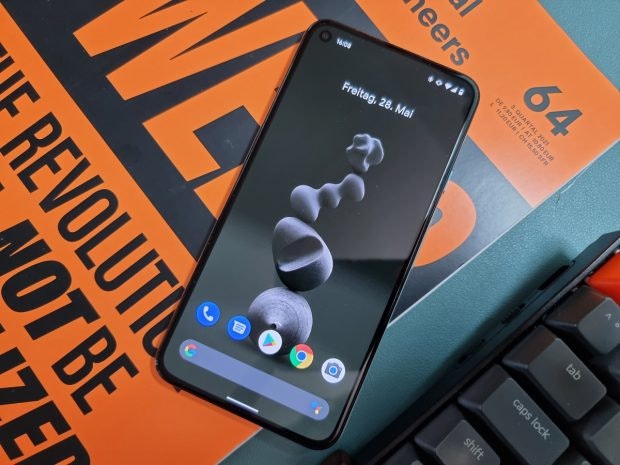
With the guest mode, the data on your Android smartphone is safe. (Photo: t3n)
You can find the setting on most smartphones under Settings> System> Advanced> Multiple users. To switch between your own profile and guest mode, all you have to do is go to quick settings or the lock screen.
Explained in detail: Guest mode: This hidden Android function is a practical privacy protection
Chrome: Save websites as PDF
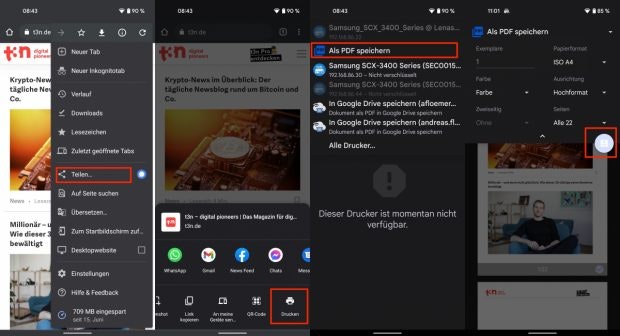
With the print function of Android, websites can also be saved as PDF. (Screenshots: t3n)
Most people will be familiar with the fact that you can print out websites or documents using the Android Chrome browser; in the Share menu of the browser under Settings, Google has integrated another function with which you can create a PDF from a website. For this you first have to Print menu and tap on the small arrow to the right of the displayed printer. Another selection now appears in which you select the point “Save as PDF“Should find. Now you tap on the button “Save PDF” and it is already in the internal memory for further processing.
Open QR codes on Android without an extra app
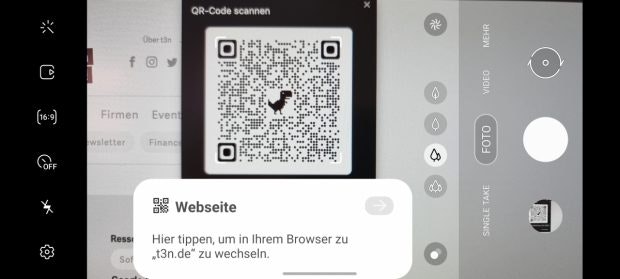
What iPhones can do, Android can do even more: QR codes can be read in the camera app. (Screenshot: t3n)
Thanks to the corona pandemic, QR codes are all the rage. The Corona warning app and the Luca app have one integrated, but the camera app also has its own on board. This proves to be useful not only when checking into restaurants without Luca. Depending on the Android attachment, the smartphone’s camera app supports automatic detection – for example on Samsung or Google devices. With other manufacturers, a small icon for Google’s lens function is integrated, which you have to tap to scan the QR code. After a successful scan, you will usually see a link stored in the code on which you have to tap.
Android function: pause individual notifications
If you do not want to or cannot deal with a certain notification or task immediately, Google offers you the option of letting it dormant for re-submission for selected periods of time.
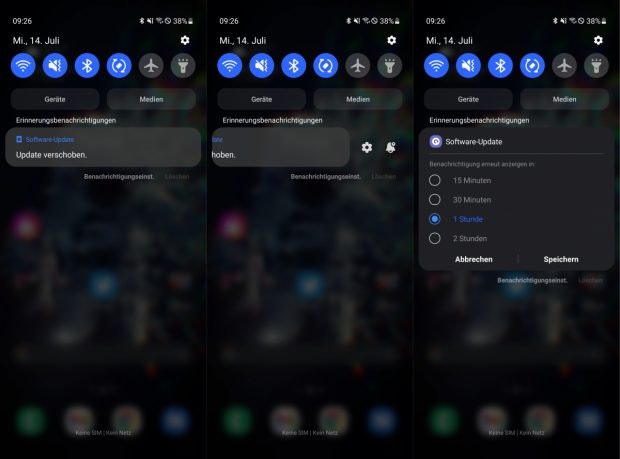
You can set individual notifications to be resubmitted on Android. (Screenshots: t3n)
For example, if you receive an email or message that you don’t have time for, open the notification bar and slide the respective notification to the left or right; a gear and a clock are displayed here. Tap on the clock and select the time at which you want to be shown the notification again. Values between 15 minutes and two hours are available here.
Mute or turn off notifications in Android
If an app you have installed sends you annoying or unnecessary notifications, take it to you next time and put it in its place. At the app level, you can specify what kind of notifications an app can send out. For example, you can determine whether you receive an audible notification or whether the app only draws your attention to new information visually. There is also the option of receiving notifications for certain content only. With Whatsapp you can choose whether the app shows you a notification for chat backups or other functions. Of course, this also works with other apps.
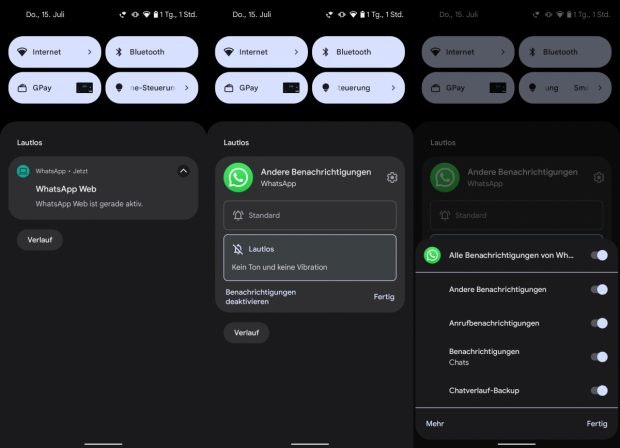
On Android, you can specify which type of notifications you want to be displayed at the app level. (Screenshot: t3n)
To call up the settings for specifying the notification types, use the function Disable notifications.
Only from Android 11: display missed notifications
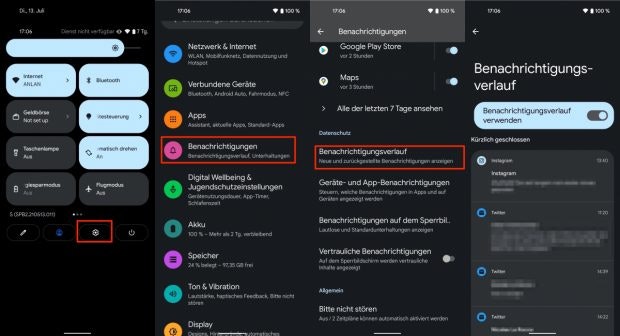
You have to activate the “Notification History” and have only been available since Android 11. (Screenshots: t3n)
If you have accidentally acknowledged one or even all of the displayed notifications, but you want to know what you have missed, you can view all information from the last 24 hours in the notification history. The function has only been around since Android 11, but offers a certain added value.
The function is deactivated by default and can be found in the Settings under Apps and notifications > Notifications > Notification history activate.
Save time: open quick settings with 2 fingers
The quick settings are the easiest way to access WLAN and Bluetooth settings, to activate dark or airplane mode or a mobile hotspot. To open the complete view immediately, swipe with two fingers from above into the display. If you swipe with just one finger, only a small section is displayed, only the second swipe reveals the full view. Ergo: You save time with two fingers.


